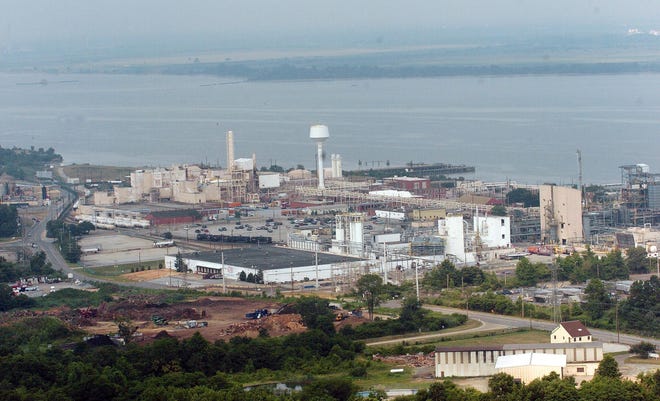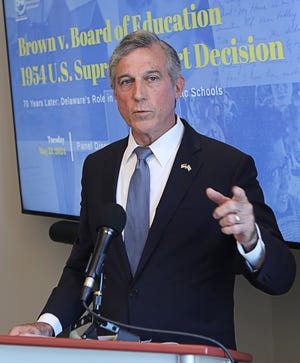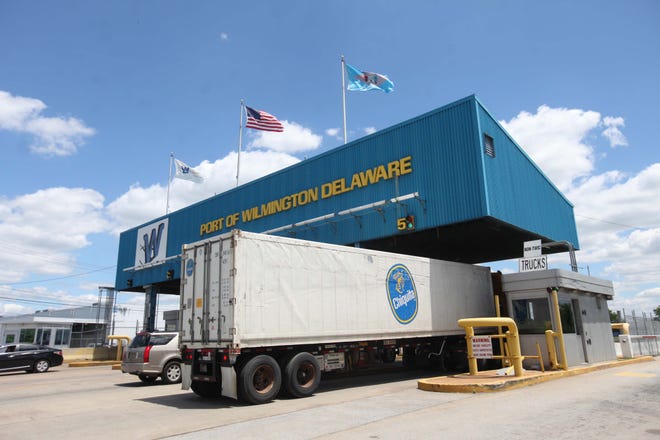This story was produced by Spotlight Delaware as part of a partnership with Delaware Online/The News Journal. For more about Spotlight Delaware, visit www.spotlightdelaware.org.
Delaware Gov. John Carney’s administration is staying quiet about details of a pot of money held by the state that could become caught up in the fallout of a U.S. Supreme Court ruling – even as it is earmarked to help pay for construction of a new publicly-owned, privately-run container port near Wilmington.
Last month, Carney announced that he would pull $195 million out of the little-known pot of money to fund about one-third of the construction cost for the port terminal that has been proposed since at least 2016 for the site of a former DuPont chemical plant in Edgemoor.
Leading lawmakers and politically influential unions cheered Carney’s public-private funding plan, with many noting that it brings Delaware a step closer to accomplishing the longstanding goal of opening a modern container terminal employing thousands of workers in the state.
But, in the weeks since the governor’s announcement, his office has declined to publicly reveal the amount of money that sits within the fund that will pay for port construction. It is not a part of the state’s traditional budget-making process.
Asked whether Delaware is at risk of losing any of that money after the Supreme Court ruled last year that the state must give up one source of it, a spokesperson for the governor said in an emailed statement that the fund is “sufficient” to satisfy claims that could result from the legal fight.

The lack of transparency appears to be a direct result of the Supreme Court case, which was brought by Pennsylvania and several other states that sought to challenge Delaware’s lucrative, yet aggressive, seizures of unclaimed property held by companies that maintain their legal home in the First State.
Escheating millions
Each year, Delaware collects money from businesses that represents the monetary value of property that state officials say has gone unclaimed by its rightful owners.
Such unclaimed property could be an unused gift card, an uncashed check, or even an unclaimed stock dividend.
And, because of Delaware’s unique role as the legal home to more than 1 million companies, the state’s collection of this money – a process known as escheatment – funds an outsized portion of government business. Last year, it amounted to more than $400 million.
But, some of that money also flows to a separate fund that the state holds in reserve to resolve what it calls extraordinary claims on its unclaimed property operations. And, a portion of that fund can flow to yet another pot of money, if Delaware Finance Secretary Rick Geisenberger deems it to be in “excess” of what the state needs in reserve.
It is that little-known excess amount that Carney tapped to pay for nearly a third of the Edgemoor port construction estimated to cost $635 million.
In the Supreme Court case, a string of states led by Pennsylvania argued that Delaware should not be able to collect one type of unclaimed property – MoneyGram checks – unless they are sent within the state’s boundaries.
Last year, the Supreme Court justices agreed with Pennsylvania, and the case subsequently moved to a “damages” phase, in which a court magistrate will now decide how much money Delaware must repay to other states.
The magistrate’s decision could come before construction of the Edgemoor port is substantially underway.
When reached for comment this month about the status of the Supreme Court case, a spokesman for the Pennsylvania Treasury said in an email that “the parties are working amicably to reach a resolution.”
It is not immediately clear how, if at all, a damages ruling would impact the pot of money from the excess reserve fund. But, last year Pennsylvania’s treasurer told the Philadelphia Inquirer that Delaware could be forced to pay out $400 million – a massive sum for the little state.
The statement from the governor’s spokesperson said his office would not “speculate on what amounts, if any, may be necessary to satisfy such extraordinary claims” – a reference to the lawsuit damages.
Transparency lacks
Despite the gravity of it all, some lawmakers also appear to be in the dark about the fund. In an email, state Sen. Dave Lawson, R-Marydel, who serves on the influential Joint Finance Committee that studies the state’s budget, said he has “no direct knowledge” of the fund, but noted that others in government have cited “different numbers” about its overall size.
Rep. Debra Heffernan, D-Bellefonte, a lawmaker who has had considerable influence over port issues, indicated in an email that she is aware of details of the secretive public fund, but is not “authorized to discuss the balances.”
Heffernan serves on the state board that oversees the Port of Wilmington’s operations, and represents neighborhoods that sit adjacent to the planned container terminal in the Edgemoor community.
Additionally, as co-chair of the state’s Bond Bill Committee, Heffernan is one of only two lawmakers who must approve the $195 million transfer to the Port of Wilmington’s private operator, Enstructure, for construction of the Edgemoor terminal.
“I am excited for the potential benefits of this project and do plan to approve the money,” Heffernan said in an email.
She added that her support came, in part, from Enstructure’s promise to hold public meetings with surrounding communities.
While the amount of money that sits in the secretive, port-funding fund is unknown, past year’s legislation shows that it previously was dedicated to paying for benefits owed to state government retirees.
When asked about the decision to fund port construction rather than retirement benefits, Geisenberger noted in an email that the state deposited a hefty $101 million last year from the pot of money to a trust fund for retiree health care benefits. It was the largest single allocation to the fund in its history.
Still, the state’s Other Post-Employment Benefits fund, which primarily includes health care for state government retirees, has more than $8 billion in unfunded liabilities.
That liability is expected to grow to more than $20 billion over the next two decades.
A quiet bond bill note
Carney’s announcement earlier this month was the culmination of a series of steps that began quietly two years ago with a few words written into an omnibus Delaware capital spending bill, commonly known as the Bond Bill.

It was a seemingly unremarkable change during that 2022 legislative session, as no Delaware lawmakers publicly mentioned it and no media reported on it at the time..
What the new legislative language did was introduce the term “maritime terminal” to a list of items that could be funded with the state’s excess reserve fund that derives from its unclaimed property operation.
The addition of the language occurred amid two momentous developments for Delaware.
One was Delaware’s looming U.S. Supreme Court legal fight against Pennsylvania over the money it collects in unclaimed property.
The other was the rapidly deteriorating financial conditions at the Port of Wilmington, as operated then by the Emirati company, Gulftainer.
Gulftainer had taken over the taxpayer-owned Port of Wilmington in 2019 after its subsidiary signed a 50-year lease with the Carney administration.
The agreement capped years of efforts to privatize the port, and Carney announced at the time that it would allow the state to “get out of the business of subsidizing the port.”
But, conditions at the port languished under Gulftainer’s leadership, and the company’s promises to build a second port at Edgemoor with private dollars went unfilled.

By August 2021, a Gulftainer executive told Port of Wilmington administrative employees that their operations had suffered continuous losses, and even “ran out of cash.”
Ten months later, lawmakers approved their Bond Bill that included the authorization of money for an unspecified “maritime terminal.”
A year later, state officials canceled Gulftainer’s port lease and instead installed Massachusetts-based Enstructure as the new operator of the facility.
Just before Enstructure took control of the port, lawmakers passed their annual Bond Bill that again included a line to authorize the distribution of an undisclosed amount of money from the little-known excess reserve fund to a “maritime terminal.”
That bill passed just months after Supreme Court justices ruled in favor of Pennsylvania in its challenge to Delaware’s unclaimed property collections.
Asked last July about the language that directed money to a “maritime terminal,” Geisenberger confirmed that it was intended to fund construction of a new container port at Edgemoor.
He declined at the time to reveal the amount of money that was in the fund that would pay for the construction.
“Such amounts are not public as they relate to pending litigation,” Geisenberger said in an email last July.
Get stories like this delivered to your email inbox by signing up for the free newsletter at spotlightdelaware.org/subscribe.













